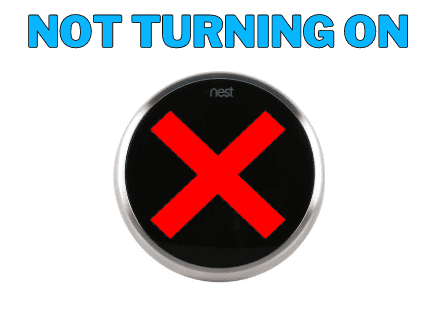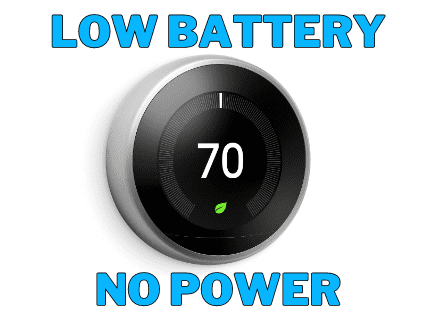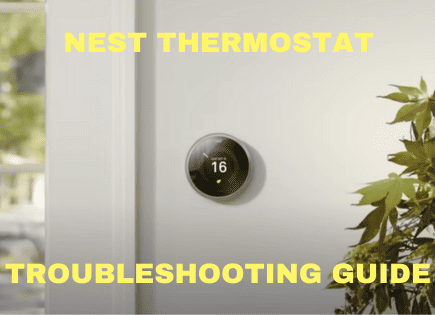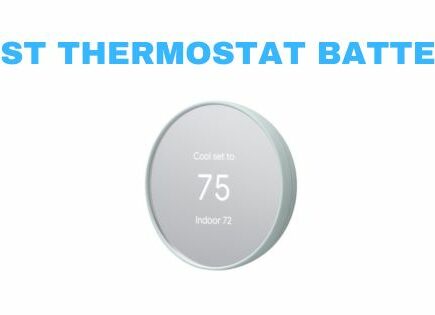
Nest Thermostat Blinking Red (Multiple Fixes!)
I’ve been using Nest Thermostats for many years now and absolutely love the product. Nest created one of the best smart home products and, after 10+ years on the market, it is still the most popular smart thermostat!
After a few years of using a Google Nest thermostat, I ran into an issue. My wife and I came home from work one day and found that the thermostat was not working.
The thermostat screen was blank and had a blinking red light at the top. I jumped into action to find a solution and managed to find a few.
Nest Thermostat Blinking Red Light
A blinking red light indicates that your Nest Thermostat’s battery is charging. Typically, this means that your Nest Thermostat lost all or most of its power and is not receiving enough consistent power. A quick fix would be to charge your thermostat using the USB port on the back of the Nest. A better solution would require getting your thermostat continuous power through a C wire or common wire.
Why is my Nest thermostat blinking red?
Most smart thermostats have an internal rechargeable battery. If the battery does not receive enough consistent power to charge the battery, the device will begin to shut off core functions to save energy.
Traditional thermostats did not require as much power and only needed it to send quick signals to your HVAC system. Smart thermostats are constantly sending signals via WiFi which uses significantly more power.
Typically, a smart thermostat will receive enough power from the R wire to keep the battery charged. But over time, the battery will slowly drain, even over several years!
This is why my Nest thermostat suddenly stopped working after we had been using it for almost 2 years!
You’re not alone! Many users face a battery issue like this or one of a few other issues like low battery or the thermostat is not turning on.
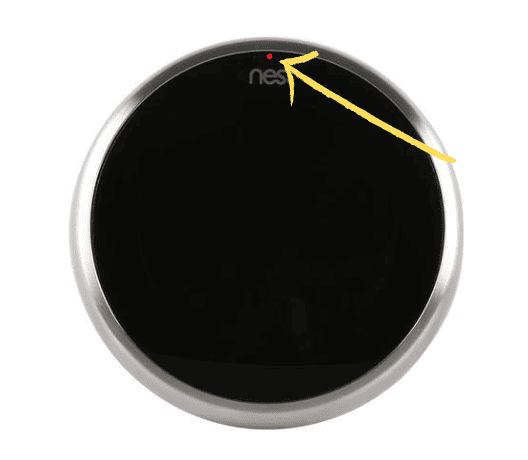
How to troubleshoot Nest Thermostat Blinking Red
When you have a Nest Thermostat flashing red light, it is likely that you have a wiring issue. To understand if that is your situation, remove the display from the thermostat base.
Note: If the blinking red light just started, give it up to one hour to charge. It just might fix itself!
Check the Wiring
You will likely have 3-5 wires connected to your Nest. Below you will find a breakdown of each and its purpose.
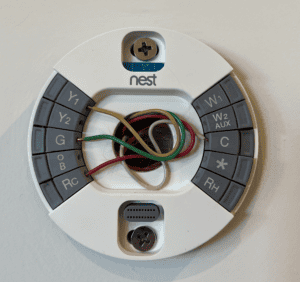
| Wire Color/ Name | Where the Wire Connects to the Thermostat | Purpose of the Wire |
|---|---|---|
| Red Wire (R wire) | Connected to Rc or Rh | This is the power wire (NOT continuous like the C wire) |
| Yellow Wire (Y wire) | Connected to Y1 | This is your cooling (air conditioning) |
| Green Wire (G wire) | Connected to G | This is the fan |
| White wire (W wire) | Connected to W1 | This is your heating |
| Blue wire (C wire) | Connected to the C | This is the Common wire that supplies your smart thermostat with continuous power |
The key to the C wire for smart home thermostats like the Nest is that it continuously powers the thermostat. Without continuous power, the battery could drain and cause a blinking red light.
At this point, it is likely that you do not have a C wire.
Below we have listed several workarounds and permanent fixes you can try.
Fix #1: Charge with a USB cable
When you pulled your Nest off the wall, you might have noticed a USB port on the back.
Although this is a short-term fix, you can charge your Nest Thermostat battery using the USB port. You WILL have to do it again in the future, but it is the simplest and fastest solution for this issue.
Your Nest Thermostat came with a charging cable. If you don’t have it anymore, there are two different cables you can use depending on which Nest you have.
For the Nest Learning Thermostat (2nd and 3rd generation) or the Nest Thermostat E, use a micro-USB. If you don’t have a micro-USB or don’t know what they look like, here’s one from Amazon.
For the Nest Learning Thermostat (1st generation), use a mini-USB. If you don’t have a mini-USB or don’t know what they look like, here’s one from Amazon.
Follow the below steps:
- Pull your thermostat display off the wall.
- Plug the charger into the Nest. Then, plug the other end into a USB wall charger. Do not use a computer or USB port from another device. You likely have a USB wall charger connected to another device, like an iPhone charger.
- Make sure a blinking red light starts again at the top of the device. This confirms when it is charging.
- Charging could take several minutes or up to an hour. If it takes longer than an hour, you might have an issue with the internal rechargeable battery.
- Once the device has enough charge, the display screen will light up with a message to reconnect to the base. Reconnect it to the wall base to complete the fix.
You should have resolved your Nest Thermostat red blinking light issue, and the device should now have power. But remember, this may not be a permanent solution. Read on for other more permanent fixes.
Fix #2: Double Check Compatibility
If you aren’t certain that your Nest Thermostat is compatible, it’s a good idea to check before you move on to the next steps.
An incompatible thermostat might still work, but it won’t get enough power to keep the internal battery charged.
Google Nest makes it easy to check. Use this link to the Google Store website to check your compatibility.
IMPORTANT SAFETY NOTE: Turn off all power at the circuit breaker!
When working with electrical wires, be sure to turn off the circuit breakers in your electrical panel. For your thermostat, you can turn off the circuit breakers. For your furnace, you can turn off the circuit breaker or unplug it.
Fix #3: Check for an Unused C Wire
Sometimes the C wire was never connected. This would be lucky, but it’s possible.
To begin, detach your Nest Thermostat from the wall and inspect its wiring. Look to see if any wires remain unconnected. Is there an unconnected blue wire that has been tucked into the wall? You may need to remove the wall plate to locate it.
You can also check at the furnace. Look for the control board with the other wires attached to them. It is likely behind a metal panel, and you’ll have to remove a few screws to get to it.
Refer to the below image for an example of what your control board might look like.
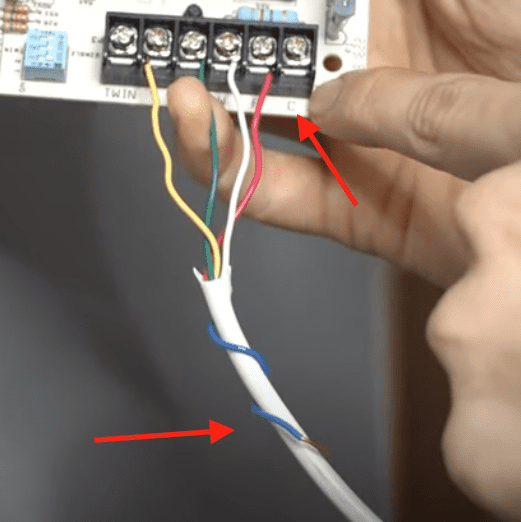
If you found an unconnected blue wire, try this solution. If not, move on to the next solution.
Follow the below steps:
1. Be sure you turned off the power to the furnace and the thermostat.
2. At the furnace, unwrap the unused blue C wire.
3. On the control board, use a screwdriver to unscrew the C with just a couple of turns. You’re just loosening, don’t take the screw out.
4. This step might be slightly different depending on the furnace at your home. Make a hook with the metal piece at the end of the blue wire and connect it to the screw above the C. There could also be a terminal that you slide the wire into directly. In both cases, tighten the screw once you’ve attached the wire.
Note: A wire might already be connected to the control board’s C terminal. That is coming from your outside air conditioning unit. That is OK, you can connect a second wire.
5. Once the wire is connected to the furnace, it is time to return to the Nest Thermostat’s wall plate. Find the blue wire and plug it into the C.
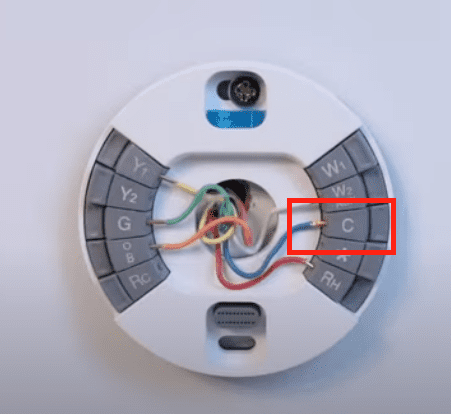
6. Reattach the Nest Thermostat back on the wall plate. You might see a red light blinking again. The battery should now truly be recharging. Give it at least one hour to fully charge.
Now that you’ve connected the C wire, you should never face battery charge or power issues again.
Fix #4: Use the Google Nest Power Connector
Google Nest knows its customers have been facing power issues with their thermostats, and they created the Google Nest Power Connector for customers who do not have a C wire.
You’ll have to buy the device. Here is a link to the Google Store, or you can check the price on Amazon.
Note: If you want to avoid spending any money, head down to the next section.
Here’s an explanation directly from Google Nest.
Since this solution was designed by Google Nest specifically for a missing C wire, you can bet it’s a great, long-term fix. With this device, you will no longer have a Nest Thermostat blinking red or low battery issue.
If you don’t want to spend the money or don’t want to wait for it to arrive, the next fix might be the right solution for you.
Fix #5: Use the G Wire as a C Wire
Here’s a free solution that will work for most of you that requires switching one wire.
You can use your G wire for your fan as the C wire (common wire) to power your Nest Thermostat.
The one downside to this solution is that you will lose your ability to use your fan. That means your fan on its own. It will still work to blow cold air when you turn on your AC unit.
Consider how often you use your fan on its own. Most people rarely, if ever, use their fan. Losing this feature is not a big deal for the majority of users.
Note: You will need wire cutters if you have central air conditioning.
Follow the below steps:
1. Start by turning off the power to the furnace and the thermostat.
2. Remove the Nest Thermostat from the wall so the wires are visible.
3. Find the G wire (green wire). Press on the plastic piece to release and pull the wire out. Now you can reconnect that wire to the C. Push it in firmly.
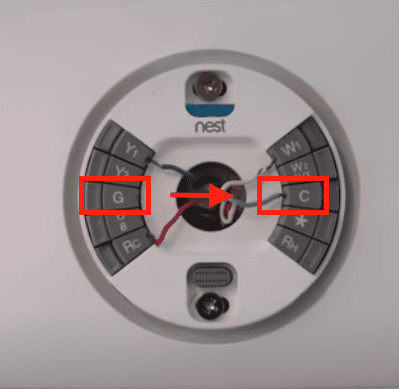
4. Go to your furnace and find the control board. You will likely need to remove the metal cover by removing a few screws.
5. Look for the 4-wire thermostat wiring and the terminal block they are connected to (see image below). It will look something like this, but many are slightly different.

Note: Two more wires will be attached to the terminal block if you have central air conditioning. Those wires will attach to Y and C. If this is your situation, you’ll have one extra step.
6. Remove the G wire and move it to the C. You’ll need to loosen the screw (don’t remove it) for both the G and the C.
7. If you have central air conditioning, you’ll need to add a jumper wire from the Y to the G. That will allow the fan to operate when your air conditioning turns on. You can cut a long piece of wire and strip both ends for your jumper wire.
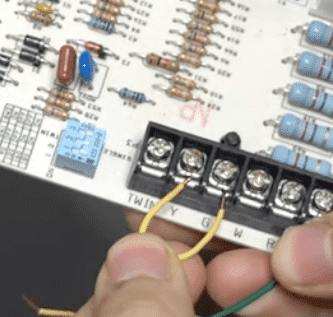
8. Now, you can close up your furnace, reattach the thermostat to its wall plate, and turn the power back on. Your Nest Thermostat should now restart and have full power.
If this is not the right fix for you, there are two more options below.
Fix #6: Use a Common Wire Transformer
Here is another option if your Nest battery won’t fully charge and you are missing the C wire. I must say this is not the best-looking solution and is not as great of an option as the solutions I’ve already covered. I don’t recommend this solution unless absolutely necessary.
You probably don’t have one of these lying around, so you will need to order a common wire transformer. Here’s an option from Amazon.
This is a 24-volt transformer that will supply continuous power to your Nest Thermostat so that the battery stays charged, and you don’t lose power.
- As always, turn the power off to the thermostat at the electric panel.
- Remove the Nest Thermostat from the wall plate.
- Insert one wire into the C and the second into the Rh or Rc.
- Insert the plug into a wall outlet.
- Reattach the Nest Thermostat to the wall plate.
- Go back to your electrical panel to turn the power back on.
Your thermostat should begin to power up and have a constant power supply.
But now you can see what I mentioned in the first paragraph of this section. There is a wire dangling from your thermostat, and that doesn’t look so great.
There are ways to hide the wire in the wall, but that will be difficult and potentially costly.
Fix #7: Convert From a 4-Wire Thermostat Wire to a 5-Wire Thermostat Wire
If you’ve reached this point, the number of wires in your Nest thermostat wiring is likely the cause of your issue.
Smart thermostats, unlike standard thermostats, require a continuous power supply due to their advanced features. They rely on a stable Wi-Fi connection and transmit data for remote access via apps like the Nest app or Google Home app, as well as energy-saving temperature features. This is why a common wire is important and why the thermostat battery drains without one.
Standard thermostats, on the other hand, do not require continuous power and often operate on alkaline batteries alone.
Many homes and HVAC systems were installed prior to the introduction of smart thermostats and, therefore, only have a 4-wire thermostat wire designed for standard thermostats.
More recently constructed or renovated homes typically have a 5-wire thermostat wire to accommodate smart thermostats.
It is feasible to upgrade your system by rewiring it with a 5-wire thermostat wire. The complexity of this task depends on your home’s construction and your ability to access areas between floors.
I recommend reaching out to a professional or conducting thorough research on how to replace wires in your specific home.
Contact Nest Customer Support
If you still have issues, I recommend contacting Nest’s customer support and contacting a local HVAC technician. They will be able to fix your Nest Thermostat not turning on.
They can diagnose and help fix problems with your system and thermostat installation.
Conclusion
Many Nest Thermostats eventually run into a battery issue that could result in a blinking red light.
You can try the many fixes we discussed that are listed below.
- Charge with a USB cable
- Double check compatibility
- Check if you have an unused C-wire
- Use the Google Nest Power Protector
- Use the G Wire as a C Wire
- Use a Common Wire Transformer
- Convert From a 4-Wire Thermostat to a 5-Wire Thermostat Wire
- Contact Nest Customer Support
It’s frustrating if your Nest Thermostat won’t turn on or if any of your smart devices stop working. Hopefully, you have now fixed your issue permanently.

